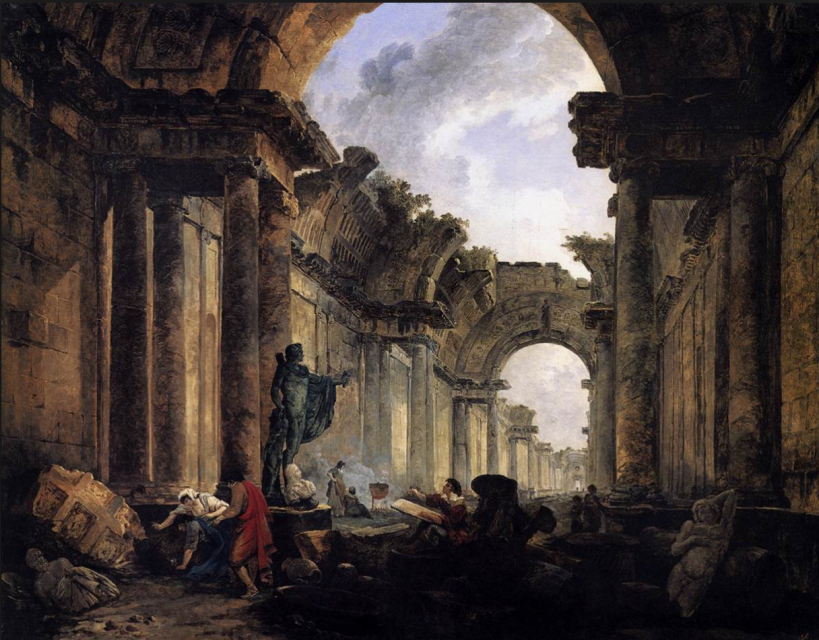
One of the most notable references in Steintrager’s Tuesday lecture was the idea that “ruination and its inevitability can be projected onto anything”. In the painting above, Hubert Robert’s infamous View of the Grande Galerie of Louvre (1796) is an oil on canvas capriccio depicting the Galerie of Louvre in absolute ruins. The functional and magnificence of the Louvre’s architecture is subjected to decay as the dilapidated walls are blended in with the surrounding foliage. What once lingered in the halls were aspiring artists are now replaced with Philistines who merely gloss over these archaeological findings or use the Louvre’s edifice as shelter. Paintings that previously filled the illustrious halls of the Louvre are strewn in disarray, deteriorating, or simply cluttered. The spatial disposition of the Louvre’s building and its seemingly endless cobbled walls are now only covered with dust – not a single painting remains looming over its nonexistent audience. Yet, at the very heart of the pandemonium, Robert inserts a promising figure – an artist poised over his sketchbook in absolute awe of the pristine state of Apollo Belvedere in all of its male bravado. On the other hand, Michelangelo’s Dying Slave, juxtaposes the former statue with its lifeless and even obsolete presence.
capriccio /kəˈprēCHēˌō/: A painting or other work of art representing a fantasy or a mixture of real and imaginary features.
The ruins of the Grand Galerie’s architecture serves as a composite of fantastical elements and a reflection of the archaeological uncoverings of Rome’s infrastructures. In this sense, Robert’s painting conveys a pertinent message on the mortality of one’s civilization, but also transcends his time. Just as his contemporaries and citizens throughout Europe are admiring the ruins of the Roman and Greek empire – from the Paestum temples, to Herculaneum, and Pompei – the artist in Robert’s painting is, too, admiring the possible ruins of Robert’s empire. As Diderot, the infamous French philosopher and art critic, stated in his writings, Salon (1776), “I walk between two eternities. Wherever I cast my gaze, objects surround me that announce an ending and that resign me to the one that awaits me”. Therefore, Robert’s popularity mainly centered around the general consensus that Rome’s demise could be brought upon any civilization and thus emphasizes the ephemeral youth of every empire in comparison to its predecessors. In other words, Robert’s depiction of ruins became a plausible, philosophical reminder of mortality amongst his contemporaries.
The overarching – no pun intended – message purveyed in Robert’s painting speaks volumes on hope, resurgence, and restoration. While not all relics can be recuperated – such as the case with Michaelangelo’s Dying Slave – the statue of Apollo Belvedere that is planted in the midst of the Grande Galerie’s disintegrating walls in tandem to the artist is a beacon of hope. In spite of the chaos, the young artist shows unwavering persistence in sketching Apollo Belvedere as he gazes adoringly at the statue while extending his arm, almost as if hoping to reach into the past in hopes of grasping something for the present. Through the Apollo Belvedere, the artist is able to bridge a gap between the generational and cultural barriers of his time and that of the statue and ultimately find sanctuary within the cryptic realms of the statue’s eminent past. Ultimately, Robert’s painting purveys two truths: the first being that ruins and reminders of the past remain prevalent in everyday society in which every civilization has a expiration date that will eventually befall them; and second, restoration is always possible, but only if one is adamant in his pursuit – even when such notions are seemingly bleak.
Works Cited
Hubert Robert. View of the Grande Galerie of the Louvre in Ruins. 1796. Artstor, library.artstor.org/asset/LESSING_ART_10310119534. Accessed 28 November 2018.
Steintrager, James. Humanities Core Lecture. ALP 1300, Irvine, CA. 08 Nov. 2018. Lecture.
Rousseau, Jean-Jacques, and Donald A Cress. The Basic Political Writings. W. Ross MacDonald School Resource Services Library, 2013.